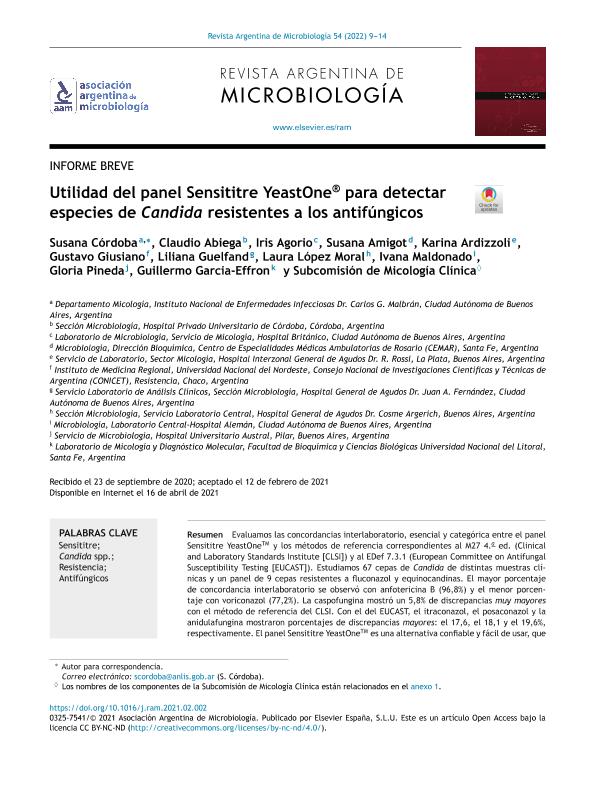Mostrar el registro sencillo del ítem
dc.contributor.author
Córdoba, Susana
dc.contributor.author
Abiega, Claudio Daniel

dc.contributor.author
Agorio, Iris
dc.contributor.author
Amigot, Susana Lucrecia

dc.contributor.author
Ardizzoli, Karina
dc.contributor.author
Giusiano, Gustavo Emilio

dc.contributor.author
Guelfand, Liliana
dc.contributor.author
López Moral, Laura
dc.contributor.author
Maldonado, Ivana
dc.contributor.author
Pineda, Gloria
dc.contributor.author
Garcia, Guillermo Manuel

dc.date.available
2022-08-10T14:18:36Z
dc.date.issued
2021-03
dc.identifier.citation
Córdoba, Susana; Abiega, Claudio Daniel; Agorio, Iris; Amigot, Susana Lucrecia; Ardizzoli, Karina; et al.; Utilidad del panel Sensititre YeastOne® para detectar especies de Candida resistentes a los antifúngicos; Elsevier; Revista Argentina de Microbiología; 54; 1; 3-2021; 9-14
dc.identifier.issn
0325-7541
dc.identifier.uri
http://hdl.handle.net/11336/164945
dc.description.abstract
Evaluamos las concordancias interlaboratorio, esencial y categórica entre el panel Sensititre YeastOneTM y los métodos de referencia correspondientes al M27 4.ª ed. (Clinical and Laboratory Standards Institute [CLSI]) y al EDef 7.3.1 (European Committee on Antifungal Susceptibility Testing [EUCAST]). Estudiamos 67 cepas de Candida de distintas muestras clínicas y un panel de 9 cepas resistentes a fluconazol y equinocandinas. El mayor porcentaje de concordancia interlaboratorio se observó con anfotericina B (96,8%) y el menor porcentaje con voriconazol (77,2%). La caspofungina mostró un 5,8% de discrepancias muy mayores con el método de referencia del CLSI. Con el del EUCAST, el itraconazol, el posaconazol y la anidulafungina mostraron porcentajes de discrepancias mayores: el 17,6, el 18,1 y el 19,6%, respectivamente. El panel Sensititre YeastOneTM es una alternativa confiable y fácil de usar, que permite detectar especies de Candida resistentes a los antifúngicos, con algunas limitaciones para las equinocandinas. Los resultados son equiparables a los de los métodos de referencia.
dc.description.abstract
We evaluated the interlaboratory agreement, the essential agreement, and the categorical agreement between the Sensititre YeastOneTM panel and the reference methods M27 4th Edition of the Clinical and Laboratory Standards Institute (CLSI), and the EDef 7.3.1 of the European Committee on Antifungal Susceptibility Testing (EUCAST). We studied 67 Candida strains isolated from different clinical samples and 9 Candida strains with resistance to fluconazole and echinocandins. The highest percentage of interlaboratory agreement was observed with amphotericin B (96.8%), and the lowest percentage with voriconazole (77.2%). Caspofungin showed 5.8% of very major errors when compared with the CLSI reference method. For EUCAST, itraconazole, posaconazole, and anidulafungin showed high percentages of major errors: 17.6%, 18.1%, and 19.6%, respectively. Sensititre YeastOneTM is a reliable alternative, and easy to perform for detecting Candida species resistant to antifungal drugs, with some limitations for echinocandins. Results are comparable to those of the reference methods.
dc.format
application/pdf
dc.language.iso
spa
dc.publisher
Elsevier

dc.rights
info:eu-repo/semantics/openAccess
dc.rights.uri
https://creativecommons.org/licenses/by-nc-nd/2.5/ar/
dc.subject
ANTIFUNGAL
dc.subject
CANDIDA SPP.
dc.subject
RESISTANCE
dc.subject
SENSITITRE
dc.subject.classification
Micología

dc.subject.classification
Ciencias Biológicas

dc.subject.classification
CIENCIAS NATURALES Y EXACTAS

dc.title
Utilidad del panel Sensititre YeastOne® para detectar especies de Candida resistentes a los antifúngicos
dc.title
Usefulness of the Sensititre YeastOne® panel to detect Candida species resistant to antifungal drugs
dc.type
info:eu-repo/semantics/article
dc.type
info:ar-repo/semantics/artículo
dc.type
info:eu-repo/semantics/publishedVersion
dc.date.updated
2022-08-08T15:15:38Z
dc.identifier.eissn
1851-7617
dc.journal.volume
54
dc.journal.number
1
dc.journal.pagination
9-14
dc.journal.pais
Países Bajos

dc.journal.ciudad
Amsterdam
dc.description.fil
Fil: Córdoba, Susana. Dirección Nacional de Instituto de Investigación.Administración Nacional de Laboratorios e Institutos de Salud "Dr. Carlos G. Malbrán"; Argentina
dc.description.fil
Fil: Abiega, Claudio Daniel. Hospital Privado Universitario de Córdoba; Argentina
dc.description.fil
Fil: Agorio, Iris. Hospital Británico de Buenos Aires; Argentina
dc.description.fil
Fil: Amigot, Susana Lucrecia. Provincia de Santa Fe. Municipalidad de Rosario. Secretaría de Salud. Centro de Especialidades Médicas Ambulatorias de Rosario; Argentina
dc.description.fil
Fil: Ardizzoli, Karina. Gobierno de la Provincia de Buenos Aires. Ministerio de Salud. Hospital Interzonal General de Agudos "prof. Dr. Rodolfo Rossi".; Argentina
dc.description.fil
Fil: Giusiano, Gustavo Emilio. Consejo Nacional de Investigaciones Científicas y Técnicas. Centro Científico Tecnológico Conicet - Nordeste; Argentina. Universidad Nacional del Nordeste. Instituto de Medicina Regional; Argentina
dc.description.fil
Fil: Guelfand, Liliana. Gobierno de la Ciudad de Buenos Aires. Hospital General de Agudos "Juan A. Fernández"; Argentina
dc.description.fil
Fil: López Moral, Laura. Gobierno de la Ciudad Autónoma de Buenos Aires. Hospital General de Agudos Doctor Cosme Argerich; Argentina
dc.description.fil
Fil: Maldonado, Ivana. Hospital Alemán; Argentina
dc.description.fil
Fil: Pineda, Gloria. Universidad Austral. Hospital Universitario Austral; Argentina
dc.description.fil
Fil: Garcia, Guillermo Manuel. Consejo Nacional de Investigaciones Científicas y Técnicas. Centro Científico Tecnológico Conicet - Santa Fe; Argentina. Universidad Nacional del Litoral. Facultad de Bioquímica y Ciencias Biológicas; Argentina
dc.journal.title
Revista Argentina de Microbiología

dc.relation.alternativeid
info:eu-repo/semantics/altIdentifier/url/https://www.sciencedirect.com/science/article/pii/S0325754121000353
dc.relation.alternativeid
info:eu-repo/semantics/altIdentifier/doi/http://dx.doi.org/10.1016/j.ram.2021.02.002
Archivos asociados
